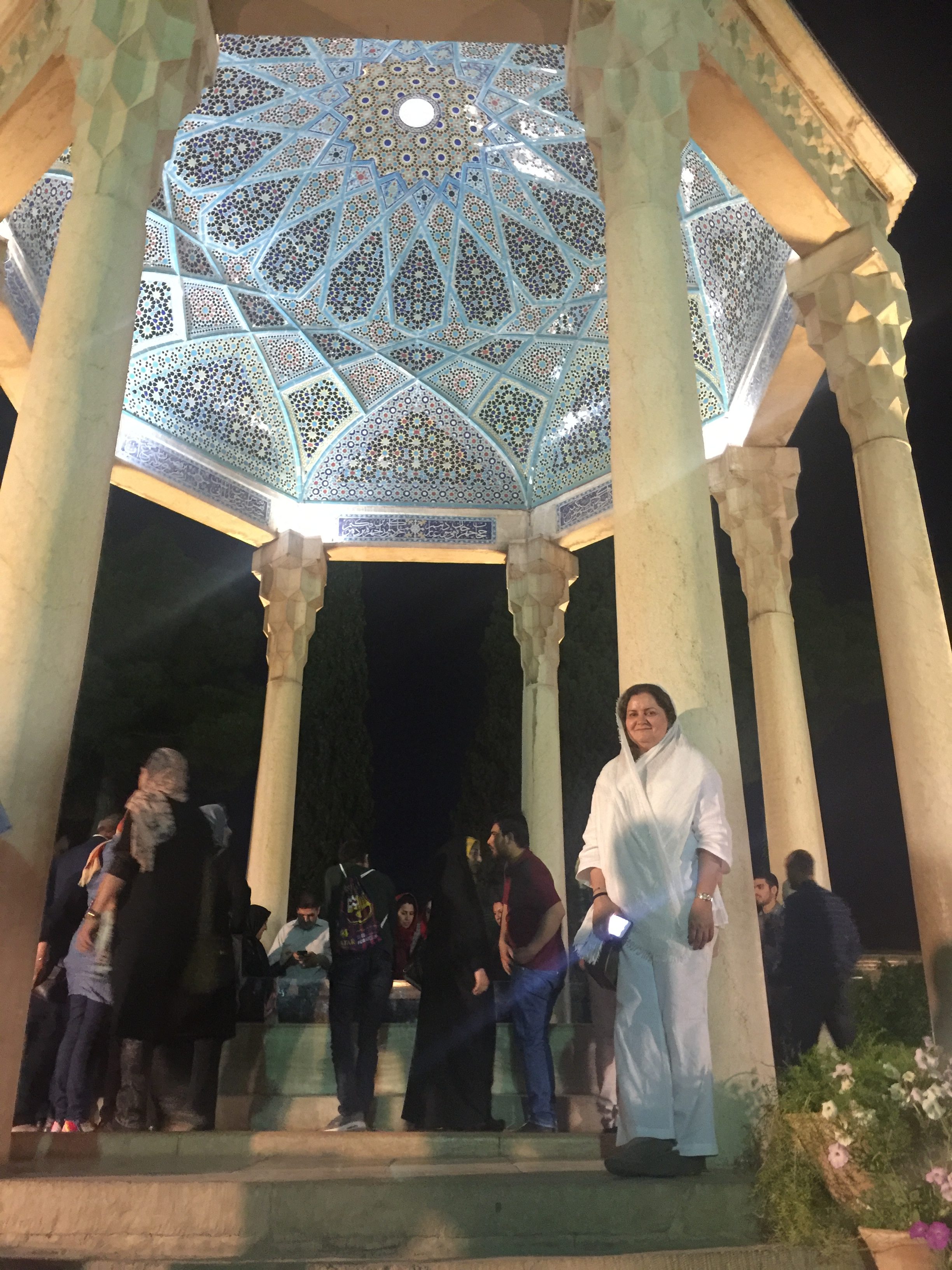
Even after all this time,
The Sun never tells the Earth,
“You Owe Me.”
Look what happens
With Love like that
It lights up the whole sky.
Hafiz Shirazi
Spring is a time of celebration, festivities and renewal in Iran. So, in response to popular demand to organize another 1818 Society Iran Tour, we decided to do so in Spring (the best time to visit Iran), keeping the same itinerary, but beginning the tour in Shiraz. We had travelers from the US, Japan, China, India, Colombia, UK,Czech Republic, Jamaica, Guatemala and Nigeria!
With the negative publicity about Iran in western media, our travelers had some concerns about the level of security, as did the travelers from our previous tour. But, as soon as they landed in Shiraz, all their worries were evaporated by the warm and affectionate Iranian hospitality.
Shiraz was a great start. The weather could not have been better. Shiraz is more than 4000 years old and is famous for many things ‒ its wide range of beautiful plants and flowers in magnificent gardens, its towering background mountains, andits famous poets. The first thing we experienced was the mesmerizing scent of orange blossoms, even more so at night. We spent three nights in Shiraz and visited Persepolis, Pasargad, Bagh-e Eram Garden, Citadel and home to Karim Khan Zand, Hafiz’s Tomb, Nasir-al-Mulk Mosque, Vakil Bazaar (Saray e Moshir), Naghsh-e-Rostam,
The next stop was the Zeinoldin Caravanserai en route to the desert city of Yazd. This beautifully-restored 400 year old caravansarai was used by traders on the legendary Silk Road from the East (the fabled Orient) to the West. The rooms are uniquely decorated with carpets on the walls and floors as they were in the past–the beds were only mattresses on a raised platform ‒ under which the ancient traders could offload and stow their precious trade goods. This way, the camels could be fed and rested in the caravanserai courtyard, ready for the next day’s journey. We enjoyed the delicious local cuisine and were entertained by the “WoodDance” performed by the Baluchi dancers. Some of us woke early the next morning to see the Sunrise. It was a unique experience and is highly recommended for anyone who wants to experience a night at the dessert, just like the camel-caravan traders of the past..
We saw fields of bright red poppies everywhere as our journey took us along the flank of the Zagros Mountains, still covered in snow. On the way to Yazd, at an ancient caravanserai (not open to the public at this time), our guide opened a concrete cover to see down into the amazing underground water irrigation canalscalled Qanats. These ancient viaducts, which could be a hundred or more miles long, tapped into mountain or underground water resources to be distributed to towns or oases. Being so old, they were all dug by hand! A recently discovered system is said to be dated back to 1000 BC. The technology was developed in ancient Persia and has since spread to other parts of the world. These systems are still being used to deliver pure potable water to many villages, towns and cities. At this site, we also saw a cypress trees that is over 4500 years old.
Before we entered into the city of Yazd we stopped at a Tower of Silence, the final resting places of Zoroastrians. The towers date back as far as the early 9th century. The corpses were left at these raised circular structures so to avoid contact with earth or fire, both of which are considered sacred by the Zoroastrians. They were left to scavenging birds to take care of them.
Yazd is the holy city for the Zoroastrians and is located in one of the driest provinces in Iran. Due to its location and its dry heat, many houses are equipped with exquisite wind catchers which operate like air conditioners. Yazd is also known to have the most adobe-built buildings in Iran. All the walls in the city of Yazd are made with mud and straw. – giving the city an earthy look. We stayed at Dad Hotel, a beautiful hotel decorated in traditional Yazdi style. The rooms open to an inner courtyard garden. The places we visited included:the beautiful Jameh mosque, boasting the tallest minarettes in Iran, Amir Chakhmaq Mosques, The Zoroastrian Village, the Fire Temple, and the Water Museum.
We traveled about 316 km to reach Esfahan. Esfahan is said to be “Nesfeh Jahan” meaning half of the world. It is one of those cities that one can never get enough of. It is a beautiful, gracious city with a large river “Zayanda Rude” dividing it into north and south quarters. We stayed at the legendary and beautifully restored carvanserai “Hotel Shah Abbas”. The hotel has a beautifully decorated and well maintained garden courtyard that has restaurants, cafe shop and is used for various entertainment. The main attraction in Esfahan is Maidan-e-Imam – a large square expanding about a kilometer and is surrounded by “Qeisarieh Bazaar” that houses hundreds of stores where you can purchase anything from beautiful Persian carpets to jewelry and spices. There are various gardens, fountains, twomosques, a treasury and a palace within the square.
Esfahan is well known for its beautiful carpets and its exquisite handicrafts such as textiles, ceramics and metalwork. We watched miniature painting (by a miniaturist who practices the art of pointillism, painting with a single cat hair using tiny dots to paint a picture). We also visited the Armenian quarter of Esfahan that houses the historical Christian church called the Vank Cathedral. Esfahan is home to eleven bridges mostly built during the 12th century. The two most famous bridges are Sio Se Pol and Khaju Pol. They are an extraordinary site at night. We visited Chehel Sotoun, Hashbt-Behesht, Alighapou Palace, Imam & Sheikh Lut-Fullah Mosques,and Jam e Mosque.
Kashan was next. Kashan is located about 250 miles south of Tehran. Kashan is known for its rose gardens and rose water. In Kashan we visited the Tababtaei House, Agha Bozorg Mosque & Madraseh and Bagh-e Fin.
One of the things that surprised some of our travelers (who perhaps have not experienced aggressive city traffic like that in Tokyo or Istanbul) was the lack of traffic rules on the streets of Iran. As one of them said “Iranians are kind, generous and hospitable until they sit behind the wheel” At first the madness and seeming ill-discipline of the city traffic is frightening as they bully their way between cars,motorcyclists and jay walking pedestrians. However, somehow in the middle of all the chaos there is an order and unwritten rules that only Iranians know to follow. With that in mind, we were very apprehensive crossing any roads. Fortunately, we had our fearless Tour Guide, Hossein, who would bravely jump to the middle of the road and stop the traffic so we could cross.
During the tour, we received a great bit of news: Ms. Nahid Jafarzadeh, founder of Touran Zamin, our tour operator, was selected as one of Iran’s Successful Woman Entrepreneur of the Year. A short 10-minute television documentary was being produced about her, and some of our travelers willingly agreed to provide testimonials.
Tehran was busy and rich with sights and palaces. We kept the best surprise for the last night. A new iconic pedestrian bridge has been built in Tehran that has won architectural awards worldwide. It is called the “Tabiat Bridge” (Nature Bridge). The bridge connects two parks located on either side of one of the city’s busiest highways, has three levels that inter-connect to each other with ramps, and houses various restaurants and coffee shops. We were honored that Ms. Leila Araghian, the young – and by now world-renowned – architect of the bridge gave us a private tour. The bridge is especially spectacular at night. We were all in awe as our bus drove by it that night taking us back to our hotel.
Every city and town greeted us with gardens full of flowers, fountains and sculptures. We were impressed by the vastness and grandeur of the landscapes, the beauty and diversity of the countryside and the friendliness of the people.
We encountered many friendly and kind people and witnessed countless acts of humbling kindness, like those who flashed a smile and wished us well, welcomed us and wanted to help. We were stopped by all ages and genders, young, middle aged and elderly, women, men and children who wanted to include us in their photos, or who pleasantly started exchanges of small talk or just a word of kindness. We were all surprised that everyone spoke if not a lot but at least few words of English. These were the moments that made me proud to be an Iranian. Everyone was also delightfully surprised by the level of security andcleanness of every city that we visited. Western images of Iran have no capacity to portray an accurate picture of Iran, to reach inside Iran to see it as we saw Iran. Scratch the surface of modern Iran, and you find a country sizzling with creativity, energy and culturally stimulation.
The word “Persia” brings into mind romance, poets, literature, history and culture. I feel it is fair to say that every one of our travelers left Iran with a better understanding of the generosity and hospitality of Iranian people. The Medes and Farsi people who left the steppes of Central Asia 3000 years ago and came to the region south of Mesopotamia, between the Caspian Sea and Persian Gulf, were nomads who passed on to their descendants, now modern Iranians, a tradition of helping each other and caring for travelers and strangers. All travelers who have followed, including us, have come to experience and share in the benefits of that hospitality ! There are of course exceptions to any rule, but nonetheless, it confirmed for us the notion that people everywhere are fundamentally good, regardless of nationality and race, and that Iran is not what it is portrayed by unknowing western media.
As many times as I had visited my home country, I have to admit that this time was the first that I was seeing Iran in the eyes of a tourist. It was a fantastic trip and I am grateful for the friendships I made during these fourteen days.
Just as all good things have to end, our journey ended in Tehran and we had say farewell.

 (wholesale) 50024335
(wholesale) 50024335